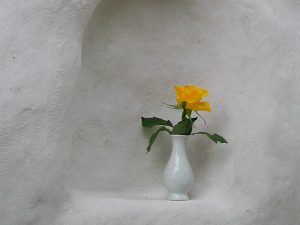One part lime putty, c. two parts water or until the consistency of full cream milk is achieved. Mix in a small tub or a bucket with a whisk. You can sieve for a particularly fine finish.
It’s very cheap paint for porous surfaces, and can be very beautiful. If done properly, won’t rub off.
If you are adding a colour to the final coat, add the pigment to a little limewash in a jam jar and shake, then add the contents of the jam jar to a bucket of lime wash. Make sure you have enough limewash for the entire final coat, because you’ll never match the colour again. Test the colour on a small patch first, because the colour will usually dry weaker than it looks in the jar or bucket. Make sure the pigment is mixed in well, or it will produce streaks.
Experiment with colours. We’ve found that yellow pigment will produce a cream colour on the wall when dry; yellow with a bit of red – yellow on the wall; red with a bit of yellow – pink; burnt umber or siena – beige.
Make sure the pigment is compatible with lime. Most are, but ask. If it is called anything umber, sienna or ochre, they are earth pigments, and are lime-compatible. Many manufactured pigments are too.
Paint on – one coat per day – for up to 6 days.
Limewash will appear transparent on the wall when wet, but will dry white unless pigments are added. When you wet down previous coats before applying another, they become transparent again. Don’t worry, the colour will reappear when it dries.
Limewash can’t be used on an impermeable surface, as it will just flake off when dry.
Spray walls between coats.
Don’t apply too thickly as this impedes carbonation, and the limewash will rub off – unless the limewash is applied hot, that is (lime putty fresh from slaking and / or mixed with hot water).
Keep mixing vigorously in a large tub, and transfer to a small tub to avoid settling.
All the limewash for a final coat should be mixed in one go, so that it matches. Limewash (including coloured limewash) can be stored indefinitely in sealed containers. So it might be a good idea to make a little more of the coloured final coat than you need, so that you have some in storage in case you need to do any patching up at a later date.
You can add an egg cup of raw linseed oil per 25 litre bucket, for waterproofing – or animal fats – BUT – it will impede carbonation, will possibly allow moulds to grow, and will impede breathability. Also, it won’t talke additional coats, so it needs to be final coat only. On balance, it doesn’t seem such a good idea to add things for waterproofing, only to lose some of the excellent benefits of lime.
Wear goggles and gloves when applying limewashes to large areas.
You mustn’t apply limewash to timber too thickly, as it will flake as the wood expands and contracts with temperature and humidity. You can apply a thin coat, then brush or wipe with a cloth when dry. This will highlight the grain, and look very attractive as well as protecting the wood. Lime wash is also a fire retardant.
Cover all floors when lime washing, as it is transparent when you apply it, so you won’t know that you’ve got white splashes all over your floor until it dries.
Costs: making your own limewash is easy, and is a tiny fraction of the cost of the cheapest white emulsion paint you could possibly find.
 limewashing over a lime render pic: Mike Wye |

